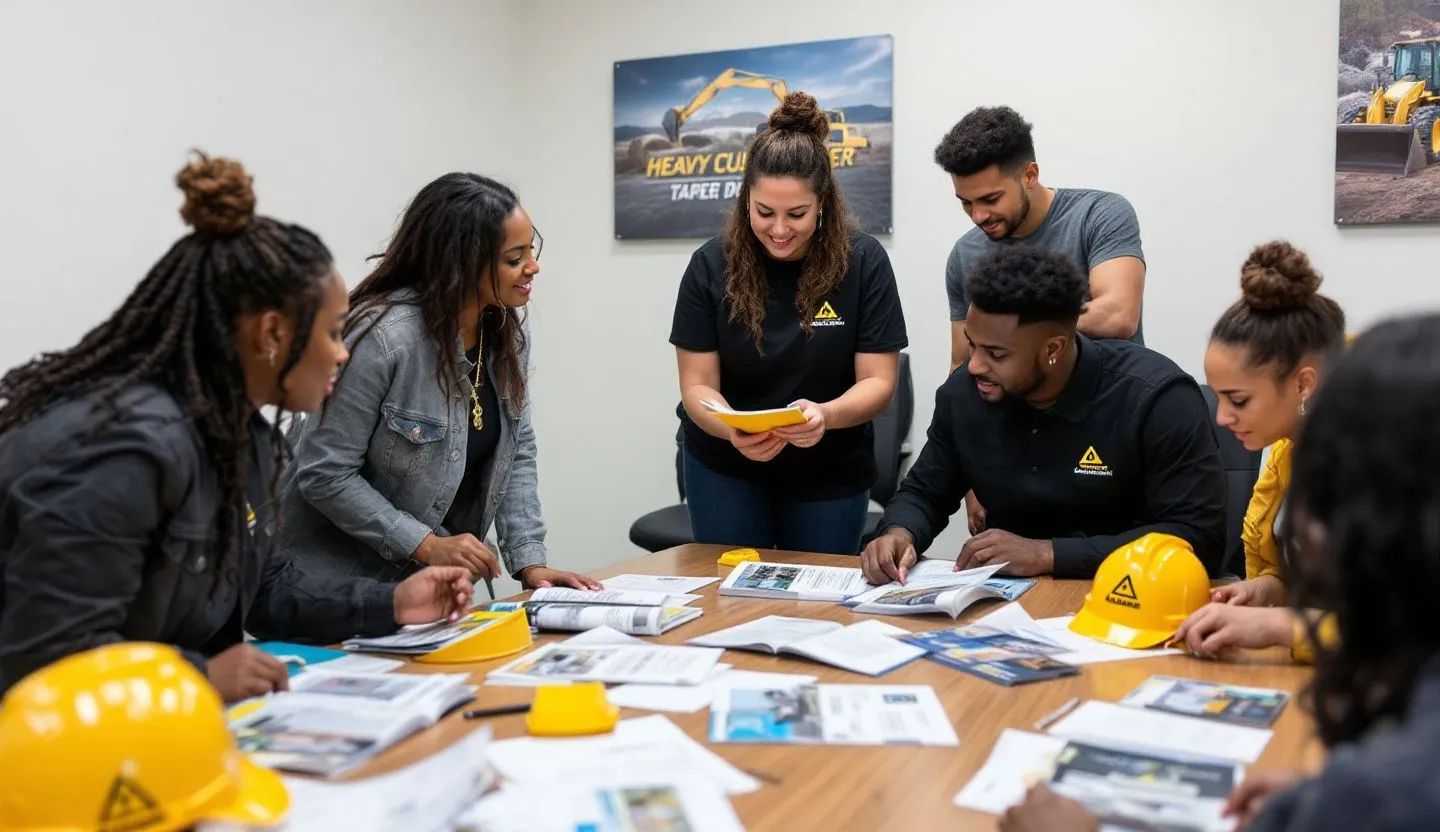If you’ve ever sat in a weekly status meeting, reviewing a batch of new dealer flyers, digital banners, or spec sheets,and felt your heart sink at the sight of an off-brand logo, a rogue color palette, or an outdated equipment image,you’re not alone. In the heavy machinery and equipment industry, we’re under constant pressure to produce more content, across more channels, for more stakeholders. But the more we scale, the harder it gets to keep every asset on-brand.
It’s the classic tension: move fast enough to serve field teams, dealers, and customers,without letting brand integrity slip. Every CMO, Head of Brand, and Marketing Ops Director I’ve talked to in this industry has lived this tug-of-war. We know that a single out-of-date logo or inconsistent brochure can erode years of trust in a brand that’s built on reliability and strength. Yet the demands keep growing.
As someone who’s led marketing and brand teams in this space, I know the sleepless nights caused by a rogue asset circulating at a trade show, or the scramble to update hundreds of dealer toolkits in a product launch. The pain is real,and so is the risk.
Why brand management is uniquely challenging in heavy machinery and equipment
Unlike many industries, heavy machinery and equipment brands are built on reputation, relationships, and resilience. Our customers,contractors, fleet managers, government buyers,make million-dollar decisions based on trust. Every piece of content, whether it’s a hard hat sticker or a fleet management brochure, is a reflection of that trust.
But our reality is uniquely complex. Assets aren’t just digital; they’re physical. Think about the sheer volume:
- Dealer signage and banners: These must be updated for every new product launch, model refresh, or regulatory change. Dealers expect on-demand access to compliant, on-brand materials,often with local customizations.
- Spec sheets and technical manuals: These are the lifeblood of our sales process. An outdated spec can cause confusion on the jobsite, lost deals, or worse, safety risks.
- Co-branded collateral: When working with OEM partners, resellers, or rental companies, every asset needs to thread the needle,showcasing our brand while honoring partner guidelines and legal requirements.
- Trade show booths and point-of-sale displays: Physical assets are expensive to produce and hard to recall if something goes wrong. A single error can echo for months.
And then there’s the people side. Content isn’t just produced by corporate marketing. Field sales, dealer marketers, product specialists, even HR teams are creating assets daily. When your content creation is democratized, brand control gets exponentially harder.
How content chaos slows down marketing and exposes risk
Let’s be honest: most of us have experienced “content chaos.” It creeps in when your brand assets live in a half-dozen shared drives, with a patchwork of brand guidelines scattered in PDFs, emails, and tribal knowledge.
The symptoms are familiar:
- Duplicate work: Teams recreate the same sell sheet or PowerPoint template, wasting hours and introducing inconsistencies.
- Brand drift: Old logos, wrong fonts, and off-brand colors sneak in as teams “make do” with what’s on hand.
- Compliance headaches: Legal, regulatory, and safety disclaimers get missed or updated inconsistently, exposing the business to risk.
- Slow speed-to-market: Every new campaign, product launch, or dealer request requires a manual review for brand and legal compliance, adding days or weeks to timelines.
- Frustrated teams: Marketers, dealers, and partners struggle to find the right assets, leading to workarounds and burnout.
For heavy machinery and equipment brands,where trust and credibility are everything,these aren’t small annoyances. They’re existential threats.
Why the stakes are higher now: What’s changing in our industry
The pace of change in heavy machinery and equipment marketing has accelerated dramatically in the last decade. A few years ago, brand teams could keep up with a handful of big campaigns and dealer updates each quarter. Now, it’s nonstop.
Several shifts have raised the bar:
- Digital transformation: Our customers expect real-time, digital-first experiences. Equipment research, comparison, and even purchases are happening online. That means content needs to be current, consistent, and everywhere,websites, apps, configurators, social media, and more.
- Dealer and channel empowerment: Dealers want to localize content quickly, reflecting regional promotions, language, and imagery. But they also expect the content to be instantly available and always on-brand.
- Regulatory complexity: From emissions standards to safety labeling, compliance is non-negotiable. A single missed disclaimer can trigger recalls or legal exposure,especially in highly regulated markets like North America, Australia, or the EU.
- Globalization: Brands are selling in new markets, with local language, imagery, and requirements. What’s on-brand in Germany may be off-base in Brazil.
- The hybrid asset reality: Teams are producing both digital and physical assets at scale,think VR walkarounds and printed spec books, Instagram stories and hard hat decals,all of which must reflect a unified brand.
These shifts mean the old way of managing brand,endless manual reviews, scattered guidelines, and ad-hoc asset libraries,can’t keep up.
What good brand management looks like in heavy machinery and equipment
At its core, Heavy Machinery & Equipment Brand Management is about building an ecosystem where every asset,no matter who creates it or where it’s used,reflects the brand’s promise of reliability and quality.
But what does “good” look like in our world?
It’s not just about having a brand book or a logo file repository. It’s about creating a system that:
- Centralizes brand assets, guidelines, and templates in one place: accessible to every marketer, dealer, and partner.
- Automates compliance: so disclaimers, legal copy, and required certifications are always up-to-date and included.
- Enables rapid localization and co-branding: without sacrificing control.
- Integrates with the tools teams already use: whether it’s your DAM, CMS, CRM, or creative suite.
- Tracks usage: so you know what’s working (and what’s not) across channels and regions.
- Secures brand assets: preventing unauthorized changes or distribution.
When you get this right, you unlock speed, scale, and consistency,the holy grail for any enterprise marketer in our industry.
Real-world pain: When brand management breaks down
Let’s make this real with a few scenarios I’ve seen firsthand.
The dealer download dilemma
A global excavator brand launches a new model. Marketing creates a fresh set of brochures and banners, then emails links to every dealer. Two weeks later, a dealer in Texas prints banners using an old logo from last year’s Dropbox folder. At a trade show, the “new model” is surrounded by outdated branding,and the confusion is clear. Customers wonder if the dealer is even authorized.
Why did this happen? The dealer didn’t have a single, trusted source for current assets. There was no easy way to verify if what they were using was approved, and no system to push critical updates instantly.
A safety regulation changes in Europe, requiring new warning labels on all technical documents. Legal, compliance, and marketing scramble to update hundreds of PDFs. But not every asset gets updated,some are missed, some live on local servers, and some are never even found.
The result? Risk of fines, recalls, and loss of customer trust.
The co-branding confusion
A rental partner wants to co-brand sales materials for a new loader. They download a PowerPoint template and swap out logos,but miss the required “Authorized Partner” language and use unapproved images. The result is a customer-facing asset that’s visually inconsistent, legally noncompliant, and damaging to both brands.
These are not edge cases,they’re daily realities in our industry. The cost is measured not just in dollars, but in lost deals, regulatory risk, and eroded brand equity.
How good brand management streamlines content operations
Solving these challenges requires more than just process. It takes a strategic, system-wide approach to Heavy Machinery & Equipment Brand Management,one that’s built for speed, scale, and security.
Here’s how a robust brand management ecosystem transforms the way we work:
Centralized access to brand assets
When every team,marketing, sales, dealers, partners,can access the latest logos, templates, images, and guidelines from a single source of truth, you eliminate confusion and duplication. No more hunting through email threads or cloud folders.
Centralization also means updates happen instantly. Change a logo, color, or disclaimer in the central system, and it’s reflected everywhere. Dealers and field teams always have the most current, compliant materials at their fingertips.
Automated brand compliance
Manual reviews are slow and error-prone. By embedding brand guidelines, legal requirements, and compliance checks into your asset creation process, you dramatically reduce risk.
For example: When a dealer customizes a brochure, mandatory disclaimers and certifications are automatically included based on location or asset type. Approvals can be automated, with alerts for exceptions. The result is faster speed-to-market and lower legal exposure.
Easy localization and co-branding
The best brand management systems empower dealers and partners to localize content,add their logo, update language, reflect local promotions,while keeping core brand elements locked down.
Templates are “smart,” allowing approved customizations but preventing unauthorized changes. Co-branding becomes scalable, not a compliance nightmare.
Integration with existing workflows
No one wants another siloed tool. Enterprise-grade brand management platforms integrate with the systems teams already use,DAMs, CMSs, CRM, project management, and creative suites.
That means marketing ops can push updates directly to dealer portals, field apps, or sales enablement platforms, ensuring everyone’s working with the same assets in real time.
Real-time analytics and tracking
It’s not enough to push assets out,you need to know what’s being used, where, and how effectively. Modern brand management systems track asset usage, downloads, and engagement across channels and regions.
This data powers continuous improvement: You see which assets drive results, which need updating, and where brand drift might be creeping in.
Enterprise-grade security and control
For IT, Legal, and Risk teams, security is non-negotiable. Brand management solutions must offer granular permissions, watermarking, and audit trails. That way, only authorized users can access, modify, or distribute sensitive brand assets.
This is especially critical for co-branded materials, embargoed launches, or regulated markets.
The impact: What’s possible when you get brand management right
When brand management is built for the realities of heavy machinery and equipment, the payoff is dramatic. I’ve seen enterprise teams unlock new levels of efficiency, agility, and brand power.
With centralized assets, automated compliance, and integrated workflows, teams can launch campaigns, update dealer toolkits, and respond to market changes in hours,not weeks. Product launches are coordinated, consistent, and on-brand everywhere.
Every asset,digital or physical, global or local,reflects the same brand promise. Dealers, partners, and field teams have the freedom to customize, but within clear, enforced guardrails. Brand drift becomes a thing of the past.
Automated compliance checks and centralized updates mean legal and regulatory requirements are always met. The risk of costly recalls, fines, or brand damage drops dramatically. Teams spend less time on manual reviews and more on strategic work.
Marketers, dealers, and partners are no longer bottlenecked by asset requests or approval delays. They can create, customize, and deploy on-brand content quickly, with confidence. This leads to higher engagement, better results, and happier teams.
With real-time analytics, marketing leaders can see what’s working, optimize content, and allocate resources more effectively. Continuous improvement becomes the norm, not the exception.
Practical steps for enterprise leaders: Building a scalable brand management system
If you’re leading marketing, brand, or operations for a heavy machinery and equipment company, where do you start?
Begin with a clear-eyed assessment: Where do your brand assets live? Who creates and distributes content? How are updates managed? Where are the gaps, bottlenecks, or risks? Involve IT, Legal, Compliance, and key partners,content operations is a team sport.
Define your brand governance model
Clarify who owns brand guidelines, who approves assets, and where dealers or partners can customize. Codify these rules in a way that’s easy for everyone to understand and follow.
Choose the right technology
Look for enterprise-grade brand management platforms that:
- Support both digital and physical assets: .
- Automate compliance and legal requirements: .
- Enable localization and co-branding at scale: .
- Integrate with your existing tech stack: .
- Offer robust security, permissions, and audit trails: .
Involve IT, Legal, and Operations early to ensure alignment on security, integration, and data requirements.
Invest in training and change management
Even the best system fails without adoption. Train your teams, dealers, and partners on the new workflows. Make it easy for them to find, customize, and use brand assets. Provide ongoing support and feedback loops.
Track asset usage, compliance incidents, and campaign performance. Use this data to refine templates, update guidelines, and continuously improve your brand management ecosystem.
The human side: How streamlined brand management changes the daily experience
Beyond the operational benefits, there’s a human impact to getting Heavy Machinery & Equipment Brand Management right. I’ve seen teams go from reactive, overwhelmed, and burned out,to empowered, creative, and proactive.
When brand management is seamless:
- Marketers: spend lessspend less time firefighting and more time building strategy, launching campaigns, and driving growth.
- Dealers and field teams: feel trusted and supported, not frustrated by endless requests or compliance roadblocks.
- Compliance, Legal, and IT teams: have peace of mind, knowing that assets are secure, up-to-date, and audit-ready.
- Creative teams: can focus on high-impact work, not chasing down old templates or fixing off-brand collateral.
The culture shifts from “catching mistakes” to “creating impact.” That’s a win for everyone.
The heavy machinery and equipment industry is built on trust, reliability, and performance,values that must be reflected in every piece of content, from the smallest digital banner to the largest printed spec book. Yet the daily reality for enterprise marketing leaders is a constant battle against content chaos, brand drift, and compliance risk. We’re asked to move faster, do more, and reach more audiences, all without sacrificing the brand integrity that sets us apart.
By investing in robust Heavy Machinery & Equipment Brand Management,centralizing assets, automating compliance, enabling localization, and integrating with the tools teams already use,organizations can finally break the trade-off between speed and control. The result isn’t just a cleaner asset library or more efficient workflows. It’s a cultural shift: marketing, sales, compliance, IT, and partners all working from the same playbook, empowered to create and deploy on-brand content at scale, with confidence.
This is more than an operational upgrade; it’s a strategic advantage. In a market where every asset is a reflection of our brand’s promise, streamlined brand management isn’t just “nice to have”,it’s the foundation for growth, trust, and long-term success. The companies that get this right will be the ones whose brands are recognized, respected, and chosen,again and again,no matter how fast the industry evolves.







